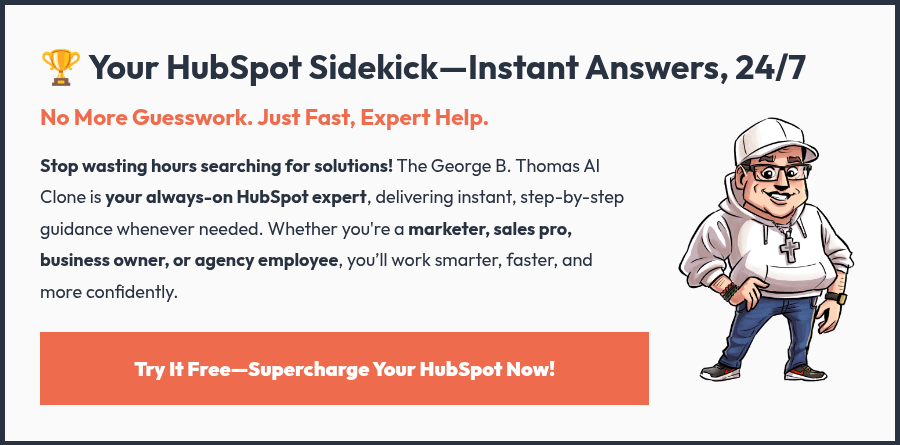9 min read
Cracking the Creator Code: SMEs, Influencers, + Thought Leaders in Your Marketing Mix (with Ashley Faus)
 George B. Thomas
Nov 21, 2024 11:39:50 AM
George B. Thomas
Nov 21, 2024 11:39:50 AM
Rather listen to this post?
Figuring out how to bring creators into your marketing strategy can feel like standing in front of an all-you-can-eat buffet with no idea where to start. You’ve got influencers, subject matter experts, thought leaders—and each one promises to be the missing piece of your marketing puzzle. But not every creator is a good fit for every brand. Trying to force it? That’s like putting pineapple on a pizza—not everyone’s going to be happy with the outcome.
That’s why I couldn’t wait to chat with Ashley Faus, Head of Lifecycle Marketing at Atlassian.
🍿 Watch our whole conversation! 🍿
Ashley isn’t just brilliant when it comes to strategy—she’s mastered the art of working with creators in a way that’s thoughtful, intentional, and, most importantly, effective. She’s seen firsthand how businesses succeed (and fail) when they bring influencers, SMEs, and thought leaders into their marketing mix, and she’s here to share the playbook.
⚡ Go Deeper: Why Do Most Companies Fail Using AI for Content?
We tackled some big questions in our conversation, including:
-
What’s the difference between an SME, an influencer, and a thought leader?
-
How do you figure out which type of creator fits your brand’s goals?
-
How do you ensure your choices align with what your audience actually needs?
The answers to these questions matter, because working with the wrong creator isn't just awkward—it's a waste of time and resources. So, in this article, here's what you're going to learn about from my conversation with Ashley:
-
SMEs, Influencers, and Thought Leaders—What’s the Difference? - Clear up the confusion and get practical tips for identifying who makes the most sense for your goals.
-
Pitfalls to Avoid When Working with Creators - Learn the most common mistakes brands make and how you can dodge them.
-
Long-Form vs. Short-Form Content and Channel Strategy - Find out how to match content formats and platforms with the right creators for maximum impact.
-
When and How to Get Started - Not sure where to begin? We’ll explore how to take your first steps and make meaningful progress.
If you’ve ever felt unsure about how to make creators work for your brand, I've got your back. So, let’s dive in.
SMEs vs. Influencers vs. Thought Leaders
Not all creators are built for the same job. You’ve got subject matter experts (SMEs), influencers, and thought leaders, and each one brings a unique set of skills to the table. It’s like building your dream team: you wouldn’t ask your goalie to play forward or expect your quarterback to kick a field goal. It’s all about knowing what they’re best at and using them the right way.
So, what’s the difference?
-
SMEs (Subject Matter Experts): These are your deep-divers, your behind-the-scenes geniuses who live and breathe your product or industry. They might not have the flashiest presence online, but their knowledge is gold. Need a killer webinar, detailed whitepaper, or an authoritative blog? SMEs are the ones to call.
-
Influencers: These folks are the crowd-pleasers, the ones who know how to turn heads and grab attention. They’re your go-to for creating buzz and driving top-of-funnel awareness. They excel at short-form, shareable content like Instagram reels or TikToks, but asking them to write a 2,000-word blog? Yeah, probably not their thing.
-
Thought Leaders: If SMEs are the brains and influencers are the energy, thought leaders are the visionaries. They connect the dots between where things are now and where they’re going. They’re perfect for strategic initiatives and big-picture storytelling, like keynote speeches, LinkedIn posts that spark discussions, or panel appearances.
⚡ Go Deeper: How to Make Fun + Memorable Content Even If Your Industry Is Boring
Here’s the kicker: success with creators comes down to knowing which role fits where. Misaligning their strengths with your goals is like using the Hulk to defuse a bomb—he might get it done, but the collateral damage won’t be pretty. Match the creator to the job, and you’re already halfway to a win.
Putting It Into Action
When it comes to choosing the right creator for your marketing strategy, asking the right questions can save you a ton of time, effort, and resources. Here’s a list of questions to guide your decision-making process and help you match creators to your goals:
-
What’s the primary goal of this campaign or project? Are you looking to educate, drive awareness, or build long-term authority? This will help determine if you need an SME, an influencer, or a thought leader.
-
Does this creator align with my audience? Consider whether the creator’s style, tone, and expertise will resonate with the people you’re trying to reach. For example, are they speaking to industry professionals or a broader consumer audience?
-
What type of content does this creator excel at? Are they known for long-form educational content, like blogs or webinars? Or do they thrive in the short-form world of reels, TikToks, and tweets?
-
Does this creator’s personal brand match my company’s values? An authentic connection between your brand and the creator is critical. Does their voice, mission, and personality feel like a natural extension of your message?
-
How does this creator engage with their audience? Take a look at their past work. Are they sparking real conversations? Do they interact in meaningful ways, or is it all surface-level engagement?
-
Can they meet the scope and timeline of the project? Even the most talented creator won’t be the right fit if their availability or process doesn’t match what you need. Be clear about timelines and expectations upfront.
-
Am I setting this creator up for success? Think about whether the role you’re asking them to play aligns with their strengths. Don’t ask an influencer to dig into technical details or expect an SME to pull off a viral TikTok.
-
How will I measure success? What does success look like for this project? Whether it’s engagement, leads, or conversions, make sure you’re aligning the creator’s strengths with the metrics that matter most to your business.
By running through these questions before you commit, you’ll not only feel more confident in your choices but also set the stage for a partnership that delivers real results. It’s all about finding the right fit and giving your creators the space to shine.
Pitfalls to Avoid When Working with Creators
Bringing creators into your marketing strategy sounds like a surefire way to boost engagement and expand your reach. But, like any strategy, it comes with its own set of challenges that can trip you up if you’re not careful. One of the most common mistakes? Trying to make a creator fit into a role that doesn’t align with their strengths.
⚡ Go Deeper: The Contentious SQL Debate Between Marketing + Sales (with Bastien Paul)
Let's say, for example, that you’ve got a subject matter expert (SME) who lives and breathes your product. They know the ins and outs, and they’re the go-to person for all the tough questions. But then you ask them to start churning out LinkedIn posts or filming TikToks like a seasoned influencer. That’s like asking a software engineer to double as a stand-up comedian—it’s just not their wheelhouse.
The same goes for influencers. They’re fantastic at drawing attention, creating buzz, and driving conversations, but expecting them to dive deep into technical content or execute thought leadership strategies? That’s not what they do best.
To avoid these pitfalls:
-
Play to their strengths. Whether you’re working with SMEs, influencers, or thought leaders, align their role with their natural skill set.
-
Don’t force a square peg into a round hole. If you’re trying to make someone something they’re not, the results will feel awkward and inauthentic.
-
Set clear expectations. Collaborate with your creators to define what success looks like for each role, and ensure it aligns with their expertise.
When you match creators with the right roles and responsibilities, the results are more authentic, impactful, and valuable for your brand and audience.
Putting It Into Action
If you’re ready to work with creators but want to sidestep the most common mistakes, here’s how to get started on the right foot:
-
Define Your Goals First: What do you actually want to achieve? Whether it’s driving brand awareness, educating your audience, or building authority, your goal should dictate the type of creator you choose.
-
Match the Role to the Creator: Take time to evaluate each creator’s natural strengths. Use SMEs for deep-dive content, influencers for buzz and reach, and thought leaders for building long-term authority.
-
Collaborate, Don’t Dictate: Creators know their audience and style better than anyone. Work together to craft a plan that aligns with their expertise while meeting your goals.
-
Set Clear Expectations Early: Before any work begins, outline the deliverables, timelines, and success metrics. Clarity upfront avoids headaches down the line.
-
Evaluate and Adapt: After a campaign or project wraps, analyze what worked and what didn’t. Use those insights to fine-tune your approach for next time.
By focusing on the strengths of each creator and building a collaborative relationship, you’ll not only avoid common pitfalls but also maximize the value they bring to your marketing strategy.
Long-Form vs. Short-Form Content: Choosing the Right Format for Your Message
Content isn’t one-size-fits-all. The format you choose—whether it’s a 2,000-word blog post or a 30-second TikTok—depends on two things: your audience and your goals. Long-form content lets you dig deep into a topic, showcase expertise, and build trust. Short-form, on the other hand, grabs attention quickly and keeps your brand top-of-mind in a fast-scrolling world.
🎤 Content Strategist AMA: Why B2B Content Programs Fail, the Future of AI + Content, + Storytelling
But it’s not about picking one over the other—it’s about knowing when and how to use each format. Think of it like assembling a superhero team. Each type of content plays a different role:
-
Long-Form Content: Best for educating, explaining, or building authority. Think whitepapers, blogs, and webinars where you have room to go deep.
-
Short-Form Content: Ideal for grabbing attention and driving quick engagement. Social media videos, reels, and tweets let you deliver snackable, shareable messages.
Why Matching Format to the Right Creator Matters
The magic happens when you align the content format with the creator’s strengths. SMEs are perfect for long-form content—they shine when they have the space to dive into the nitty-gritty. Influencers? They’re made for short-form, high-energy content that can quickly reach and excite their audience. Thought leaders can often straddle both, providing big-picture insights in a webinar or a snappy soundbite for LinkedIn.
When you try to force an influencer into a long-form project or an SME into short-form content, it often feels inauthentic. And if it feels off to you, imagine how it lands with your audience.
Putting It Into Action
Here’s how to ensure your content formats and creator strategies hit the mark every time:
-
Start with Your Audience’s Needs: Are they looking for in-depth answers or quick inspiration? Use long-form content to educate and short-form to engage and excite.
-
Pair Creators with Their Strengths: SMEs thrive with long-form projects like blogs, webinars, and whitepapers, while influencers shine with short, engaging videos or social posts. Match the format to their natural style.
-
Mix and Match Formats for Maximum Impact: A single topic can be turned into multiple types of content. Turn a webinar into bite-sized video clips or pull key insights from a blog for a LinkedIn post.
-
Choose Channels Strategically: Don’t throw content everywhere and hope it sticks. Long-form blogs live best on your website, while short-form content dominates on social platforms like TikTok, Instagram, or LinkedIn.
-
Test and Optimize: Not sure what’s working? Experiment with formats and creators, and keep an eye on engagement metrics. Learn what resonates with your audience and refine your approach.
By tailoring your content strategy to your goals and the strengths of your creators, you’ll create a cohesive mix that connects with your audience where they are—whether they’re scrolling fast or ready to dive deep.
When Should You Get Started?
That's really the only question left, isn't it?
The answer is simple: now. There’s no perfect time, and waiting until everything feels “ready” often means waiting forever. Whether you’re launching a new campaign or just trying to refresh your approach, creators can add value at any stage. The key is to align their role with your immediate goals and available resources.
⚡ Go Deeper: Is the HubSpot Content Hub Still a Business Website CMS?
Of course, getting started with creators can feel a bit like stepping into uncharted territory. You’ve got the information, you see the possibilities, but taking that first step? That’s where most teams hesitate. The good news? It’s not about doing everything at once—it’s about starting small, testing, and building momentum:
-
Clarify Your Goals: Are you looking to boost brand awareness, educate your audience, or drive conversions? Knowing your destination helps you choose the right creators and formats.
-
Start Small: Test one creator on a specific project. Maybe it’s an SME writing a blog post or an influencer creating short-form videos for a campaign. Keep the scope manageable so you can learn and iterate.
-
Leverage What You Already Have: Repurpose existing content by bringing in a creator to expand on it or adapt it to a different format. For example, turn a webinar into video clips with influencer commentary.
-
Prioritize Collaboration: Work with your creators, not just for them. Give them a voice in the process—they know their strengths and their audience best.
-
Evaluate and Build Momentum: After your first project, take a step back. What worked? What didn’t? Use those lessons to refine your approach and scale up from there.
Focus on one win, learn from it, and then keep building. Remember, this is about creating long-term value, not just checking the box on some arbitrary to do list. When you take that first step with intention, you’re setting the foundation for bigger successes down the road.
Still Need Help Getting Started?
If you’re reading this and thinking, “This all makes sense, but how do I even start finding the right creators for my brand?”—you’re not alone. The good news? You don’t have to navigate this process on your own. My team at Sidekick Strategies is here to help you take the guesswork out of building meaningful partnerships with SMEs, influencers, and thought leaders.
Whether you’re mapping out your first creator campaign, figuring out the perfect mix of content formats, or aligning creators with your long-term goals, we’re ready to roll up our sleeves and make it happen.



